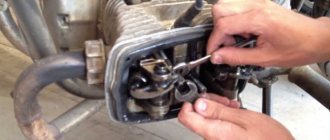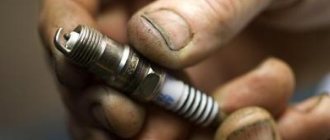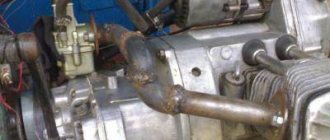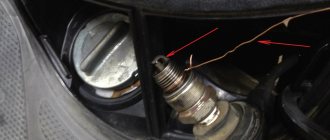Typical reasons
First of all, you need to check: the ignition and power systems. Carry out a check in those places that can cause the moped to move. The reasons why the scooter does not start, especially in cold weather, may be the following:
No spark in spark plug
The scooter does not start because there is no spark in the spark plug. In this case, you need to do the following: the spark plug is unscrewed and checked for suitability. Connects to the ignition coil using a wire. Placed on the cylinder. When the crankshaft rotates, the spark at the spark plug is checked. The scooter will not start if there is no spark at the plug, or there is a spark, but it is inconsistent.
Reasons for the lack of spark on the spark plug
Cold weather
The scooter may have difficulty starting in cold weather if there is a problem with the spark plug cap or its connector. In such a situation, the cap is unscrewed from the wire, and the wire is brought 0.3 cm closer to the metal motor element to crank the crankshaft.
A moped can carry current in cold weather. This happens due to the fact that there is contact with the exposed part of the wire and the metal element due to which the scooter starts.
Malfunctions in the power system
A moped may have difficulty starting in cold weather if there is a problem in the power system: lack of fuel or its excess. In this case, you need to check the following elements: gas tank, fuel tap, starting enrichment and fuel pump.
First of all, check the moped's fuel pump
Along with this, it is worth noting that the moped needs to be repaired, and parts should only be disassembled if there is complete confidence that they are faulty. It is best to install only new parts on the scooter, and not used ones, otherwise the engine, when started from the starter, will either work poorly or will not start at all.
Typical problems with the ignition system of Chinese scooters
There are times when scooter owners are faced with the problem that it will not start.
The reasons for this can be different, but there are also quite typical ones. In some cases, fixing the problem takes a few minutes. Let's look at several reasons that lead to the scooter not starting. All examples are real, obtained during the repair of the Chinese scooter ABM Storm L and Motoland VXR5 .
The scooter does not start with the button.
If the scooter does not, but starts from the kickstarter without problems (from the “leg”), then you should pay attention to the main fuse, which is located in the battery compartment.
This same fuse may be the cause. There was a real case when, when measuring the voltage at the battery terminals, 13 volts was displayed on the multimeter display. The norm, considering that the battery was slightly discharged.
When measuring the voltage after the fuse, the multimeter showed 12.8 volts. Wonderful, isn't it? Does a piece of wire (fuse) really drop 0.2 volts? In theory, this shouldn't happen. The voltage in the scooter's electrical network after the ignition switch was also measured. The voltage was a little more than 5 volts and was fluctuating. The turn signal relay also began to crackle ungodly after the scooter was started with the kickstarter and the turn signals were turned on.
Due to the fact that the fuse was made, to put it mildly, poorly, the wire inside the glass bulb barely touched the contact caps. Because of this, the electrical contact in the fuse was poor. This is where those 0.2 volts of voltage were lost.
Due to the fact that the turn relay received undervoltage, it crackled, since the supply voltage was sometimes enough to operate the electromagnetic relay, sometimes not.
Also, when pressing the “Start” button, the starter, which spins the engine shaft when starting, did not start. Naturally, since the voltage in the scooter's electrical network was underestimated due to a faulty fuse.
After replacing the faulty fuse, the scooter began to start with the “Start” button.
In case of such malfunctions, you should first check the integrity of the connecting conductors in the engine starting circuit. If you don't have a scooter wiring diagram handy, take a look here. There you will find a scooter wiring diagram that is suitable for almost all Chinese scooters.
Let's look at another problem.
The scooter does not start either from the start button or from the kickstarter.
What could be the problem?
Many people encounter this problem when they try to start a scooter after winter. In this case, the scooter seizes, but does not start. The electric starter turns, but something is missing to start the engine itself. The cause may be old fuel left in the gas tank. It is better to drain the old fuel and fill the tank with new one.
Another possible cause could be the spark plug and the wires that connect the CDI ignition module, ignition coil and spark plug.
First, it is better to check for the presence of the spark itself. You can do it like this.
To check the spark on a scooter you need to get to the spark plug. To do this you will have to remove the seat and find the cap.
The spark plug cap is removed with a little effort. It is attached to the candle with an elastic metal clip, which is built into the cap.
There is no need to twist the cap with the wire clockwise! Some people do this to remove the cap. This can damage the contact between the wire and the cap.
The spark plug can be unscrewed using a socket wrench. I filmed it like this.
Next is actually checking the spark.
We insert the spark plug into the cap and lean the outer metal edge of the spark plug against the metal body of the engine. Just like in the photo.
This is how we connect the negative, common contact of the spark plug with the common wire of the scooter's electrical wiring. Then we turn the spark plug so that we can see the gap where the spark should jump. Press the “Start” button, as we do when starting the engine. In this case, you will most likely need the help of another person. One is uncomfortable.
When you press the “Start” button, a bright white spark . If the spark is blue-green, then most likely you need to clean the spark plug and at the same time check the contact of the high-voltage wire and the spark plug cap. It's done like this.
In Chinese scooters, the high-voltage wire that connects the ignition coil and the spark plug is attached to the spark plug cap in a very unreliable way. The wire is simply screwed onto the metal screw of the cap. In this case, the metal screw simply cuts into the strands of the copper wire. Vibrations and shaking may cause this contact to weaken.
If the spark is weak, then it would be a good idea to update the contact between the high-voltage wire and the spark plug cap. To do this, you just need to shorten the high-voltage wire by 0.5 cm. In this case, the copper wires will be fresh and not broken. Next, simply screw the end of the high-voltage wire onto the screw of the spark plug cap. After this you can check the spark. If there is a spark and it is bright, then put the spark plug in place and put on the cap. We check if the scooter starts.
Do not forget that the reason for the engine not starting may be failures not related to the electrical equipment of the scooter.
Reasons for lack of spark
Often, owners may encounter cases of starting failure in the cold season, although the moped drove well in the autumn. Initially, you need to unscrew the spark plug and carefully inspect for spark, oiliness and color.
Carbon deposits on the electrode
There may be no spark, if the electrode is covered with carbon deposits, then they are cleaned with a metal brush. If there is even the slightest doubt about the serviceability of the spark plug, you should replace it immediately, thereby making your life easier in the future.
Acidification of contacts
If the external signs of the spark plug correspond to suitability, and there is also no spark, then you need to check whether there is a discharge. It is worth noting that you need to be extremely careful, as it can give you an electric shock. If there is no spark and the external signs of the spark plug are normal, then the scooter is checked electronically for acidification of the contacts.
Insufficient fuel
If there is a spark, but the moped still has difficulty starting from the starter in cold weather, you should pay attention to the fuel tank. If it is empty, then it is filled. It is worth noting why old gasoline pours out of the carburetor float chamber. How to do it? There is a bolt at the bottom of the carburetor; it is unscrewed, and after all the fuel has flowed out, it is screwed back in. Before putting the moped in the garage in cold weather, fill the tank full of fuel.
Unscrew the bolt and pour out the old gasoline from the carburetor float chamber
If the above has been checked and done, and the scooter does not start well from the starter, then you can make the following repairs:
- The carburetor is removed and the air filter is cleaned;
- The carburetor is cleaned, the jets and channels are purged;
- Everything is coming back together.
How to restore starting from the starter
The moped does not start well from the starter, however, doing it from the foot is simple and easy. If the engine does not start well from the starter, you must first check the fuse located in the battery compartment.
The location of the fuse on the battery is marked with an arrow.
Due to the often poor quality of the manufacture of the fuses, and, consequently, the entire starter, the wire located inside the starter glass bulb can barely touch the contact caps, which is why the fuse contact becomes unsuitable. After the low-quality fuse has been replaced, the moped can be started using the starter.
How to do your own engine repair
For a scooter engine to function properly, it requires the following components: spark, fuel and compression. The main slogan of a scooter mechanic is that miracles do not happen. Remember that in the process of troubleshooting and repairing a scooter, you can find out whether there is a spark and compression, or why there is no fuel flow. Therefore, if the engine does not start from the starter, then some component is missing or is in a faulty condition.
Many people are familiar with the situation when they are not only too lazy to take their scooter to a workshop, but also don’t want to pay for it all. Then you can repair everything yourself.
Sequence of repair actions
The main rule for detecting malfunctions and repairing a scooter is to step-by-step eliminate the elements of the system when identifying the causes of a breakdown in any of them. Search and repair, especially when starting from the starter, must be done in accordance with a strict sequence, where the chain may act as the beginning, and the end, for example, if there is or is no spark. It is worth noting that you do not need to immediately run for a new switch for the scooter, first make sure that the generator is functioning perfectly, only after that test the wiring if there is no spark, etc.
Checking Basic Systems
It is important to remember that gasoline has the ability to lose its properties if it sits in cold weather and may not even ignite. Also, before making a final diagnosis and starting to repair the moped, if it does not start from the starter, you need to make sure that the spark plug can do its job and the carburetor is functioning normally.
Remember that the scooter starts from the starter when it has an integral part with proper operation of the variator, clutch, camshaft group and valve. To put it simply, if all power systems are in normal condition, then there is a problem in the transmission, thanks to the crankshaft torque, which works closely with the variator.
In the process of diagnosing and repairing a scooter, in some cases it is necessary to do a thorough check of not only individual elements, but also the entire system. For example, if there is debris in the carburetor, provided that it is intact and the air filter is saturated, the presence of dirt in the cavity of the gas tank and the fuel filter is also carefully examined.
Why does the scooter stall at idle?
A scooter, like any piece of equipment, can break down over time. Therefore, it needs to be checked and maintained from time to time. If the scooter is not serviced in a timely manner, it will therefore not serve you for a long time and faithfully. Even Chinese devices serve faithfully in capable hands. Today we will talk on the topic: “Why does the scooter stall at idle.”
Scooter stalls at idle
It happens that the scooter works well and picks up speed without problems. But if you release the throttle, the scooter will go into idle mode and stall. Most often this happens when it has not yet warmed up and without accelerating it stalls. But it happens that this happens after warming up or driving for a long time. What to do in such cases? Why does my scooter stall at idle? If it has not yet been run-in, then most likely you should just finish it and everything will work out. But if this is not related to the running-in, then we are looking for the reason.
Stalls at idle: reasons
The reason that the scooter stalls at idle may be a lean mixture (or a breakdown in the fuel system) or bad gasoline. Before starting repairs, check the quality of gasoline. If this starts after refueling, then you need to drain the gasoline and refuel at a proven gas station (you can rinse the tank with acetone). If this does not help, then you need to check the enricher itself and the mixture enrichment channels. If there are no problems there and the scooter stalls at idle, then we move on. We check the entire fuel system: - Carburetor. We remove and disassemble it. We completely wash every part and every channel. We put it back together in the same order as we took it apart. — Air filter. The paper one needs to be blown out with a compressor. If the condition is completely bad, then you need to replace the filter. We wash it with gasoline and dry it a little. Then soak it in oil. Squeeze out any excess glass in your hand. — Vacuum valve. Remove both hoses from the carburetor. We take the thin one into our mouth and suck it into ourselves. This is done to create a vacuum. At this time, gasoline should actively flow out from the other hose. If gasoline flows out sluggishly, you need to remove the vacuum seal and rinse, blow out, and clean it. After this, warm up the scooter well and adjust the idle speed.
If the scooter continues to stall at idle, then the possible reasons are: - The electric enrichment unit is jammed or incorrectly installed - The jets or the enrichment channel are poorly washed - The air filter is not sufficiently saturated or not saturated at all. — The carburetor is in poor condition. To check, you can tighten the quality screw completely and unscrew it one turn. This will be a very rough setting that will need to be reconfigured, but now you can check it will fix the scooter stalling at idle.
scoteram.ru
Causes of malfunction
Due to a flooded spark plug, the scooter may not start at all or may be unstable. So, what could be the reason:
- Clogged air filter. Insufficient air supplied to the carburetor enriches the fuel mixture. As a result, a large volume of fuel does not have time to burn in the chamber, and the spark plug becomes dirty.
- Incorrect carburetor adjustment. A tightened mixture quality screw on the carburetor has almost the same effect as a clogged air filter.
- Faulty ignition system. There are several faults at this point: faulty spark plugs - bad wires - problems with the ignition coil - incorrect timing (on old equipment, for example).
- Poor quality fuel. Gasoline diluted with another liquid greatly affects the contamination of the spark plug.
Oddly enough, the spark plug on the injector can also flood. This usually happens in winter on worn-out engines. Since the quality of the mixture is regulated by an electronic control unit (ECU), it would seem that the spark plugs should not be flooded.
However, poor compression, a discharged battery, a bad starter, an insufficiently powerful spark and incorrect electrode gaps do not allow the scooter to start at subzero temperatures. In cold weather, the ECU supplies more fuel to the cylinder, since cold air contains more oxygen than hot air.
For a number of reasons described above, the scooter does not start and the spark plug is flooded.
We are trying to start the engine
So, we figured out why the spark plug on the scooter floods. The repair methods and starting methods below apply to scooters with 2T and 4T engines.
- The method is suitable if there is no tool. If you flooded the spark plug while trying to start the scooter, then give it time to stand for about 5 minutes. Then turn the gas handle all the way and turn the engine with the starter for about 10 seconds. You can use the foot several times if the starter is faulty. Release the throttle and try to start the engine again - it should work.
- If you have a spark plug wrench, you should unscrew the spark plug and warm it up over a fire, after cleaning it from carbon deposits. With the spark plug removed, you should “blow out” the cylinder by rotating the engine with the starter or foot. Screw in the spark plug and try to start. If unsuccessful, the spark plugs should be replaced.
Advice! Although the first method is faster, it is still recommended to use the second. This cleaning of the ignition system will help avoid such problems for some time.
Eliminating the causes of the malfunction
If after performing the manipulations the scooter starts, that’s good, but you shouldn’t relax. Be sure to check for possible faults. What to do to prevent this situation from happening again:
- Clean or replace the air filter. You can make sure that this is the reason by simply trying to start the engine with the filter installed and without it.
Advice! If the condition of your engine is far from new, then cleaning or even replacing the spark plug should be done more often.
- Adjust the quality of the mixture. Set the carburetor mixture quality screw to the optimal position (where the quality screw is located, see this article), clean the carburetor on the moped. If you have a scooter with an injector, monitor the condition of the injectors. Use an injector or carburetor cleaner.
- If you have a 4-stroke engine, pay attention to the valve adjustment. Incorrect release timing can also cause dirty spark plugs.
- The battery should always be well charged and the starter in good working order. After all, candles are often filled in in winter, and in cold weather a reliable battery is required.
- The quality of oil in the frosty season also affects the success of starting a scooter. The oil must be fresh and of the required viscosity for your local temperature.
Advice from experienced motorcyclists! If a spark plug is flooded, you should load the engine at high speeds at least once a week. This ensures that the cylinder and spark plug are purged from accumulated carbon deposits.
The scooter starts and immediately dies
Moderator: Alex174
Dongest » June 14, 2012, 00:18
Andrey8640 » June 15, 2012, 01:59
NordMoto » June 15, 2012, 08:17 pm
There can be a lot of reasons. Spark plug, carburetor, vacuum fuel valve, CPG, valves, etc.
You unscrew the spark plug and see it’s black, wet and covered in soot. We replace it with a new one. If you have a compression gauge, we plug it in and turn it with the starter, see if the CPG is alive or if the valves are holding. The problem is not resolved, let's move on. Carb problem. We check the integrity of the membrane and blow it out. (don’t forget that the CVK carb and all pipes must be intact). We check the electrovalve enricher.
Dinosaur » Jun 16, 2012 7:51 pm
Because a Jap is worth fixing and driving. And it’s easier to throw away a Chinese car with the first breakdown. Here is a quote from the owner of a Honda Lead 50. And the 90s have even more resources.
NordMoto » June 17, 2012, 00:38
Dinosaur » June 17, 2012, 01:08
I had a couple of Chinese. Now, if you'll excuse my French, I won't sit next to them to poop.
Honda had a tact - replaced the rings once and drove for five years without going anywhere beyond the filter. Lida is generally unkillable. The entire repair in three seasons was replacing the battery.
What to do if the scooter does not start? DIY repair
Detailed instructions on what to do if the scooter does not start. Useful information for scooter owners who cannot start it.
One of the most popular two-wheeled vehicles in the world is, of course, the scooter! Many people start with them, since this type of motorcycle is characterized by simple operation and an affordable price. But, as a rule, beginners have no experience in repair and maintenance. In this article we will help you figure out what to do if your scooter does not start. Let's look at standard faults that make the scooter difficult to start. The most important thing in troubleshooting is to learn to recognize it by certain signs and proceed from simple to complex. Sometimes the reason is the most banal - the gas ran out, the battery was discharged, they forgot to turn on the power button or open the gas tap (on a moped). If these conditions are met, but the scooter still doesn’t start, we dig deeper.
A dead battery is a common problem.
If the scooter does not start from the starter, try starting it from the kick starter. The most common problem is that the battery is simply dead due to a long period of inactivity, or has reached its intended service life. But it also happens that the relay regulator fails or the fuse blows. The fuse is usually transparent and its demise can be determined by eye. A malfunction of the regulator relay can be determined by starting the scooter with a kick starter and measuring the voltage at the battery contacts. It should not exceed 14.5 V. To avoid discharging the battery in the future, we advise you to remove the negative terminal, and during winter idle time, keep the battery warm, check the electrolyte level and fully charge it before storage.
If you want to upgrade your scooter, then you will be interested in the article tuning a scooter with your own hands.
Why is there no spark?
The second most common problem is why the scooter won’t start - there is nothing to ignite the fuel, or there is a spark - but there is nothing to ignite. To check the spark, you need to remove the spark plug cap and unscrew the spark plug. It must be dry and clean. The gap between the electrodes is needed 0.6-0.7 mm. The first sign of a lack of spark is that the spark plug is wet and smells of gasoline. This means the fuel did not burn in the cylinder and remained on the spark plug. Dry and clean it, then insert it into the cap and lean it against the cylinder mass.
At the same time, press the starter button for a second or the kick starter a couple of times. The spark between the spark plug electrodes should be clearly visible. If there is no spark, then replace the spark plug with a new one, most often this is the problem.
You may be interested in how to adjust the ignition on Ural motorcycles or install electronic ignition on Izh Jupiter 5 yourself.
The quality of gasoline in Russia is not very good, this quickly kills spark plugs, especially iridium ones. If a spark does not appear with the new spark plug, we look for a fault in the wiring. A broken wire or oxidation connecting the ground between the frame and the engine is a common problem. Another reason could be a burnt-out resistor in the spark plug cap. It can be checked with a multimeter; the resistance should be about 5 kOhm. If this is not the problem, then check the ignition coil, this can also be done with a multimeter. In this case, the resistance of the primary and secondary windings is checked. The resistance of the primary winding, as a rule, tends to zero. Well, the resistance of the secondary should be several kOhms. There shouldn't be a break.
It is also worth checking the switch by replacing it with a known good one.
The next possible malfunction is a break in the wire coming from the ignition switch or the wire coming from the switch. Check the wires for breaks or abrasions. Check the reliability of the female-male plug connections. If no visible damage is found, a wire break can be detected by testing each wire with a multimeter. If the above manipulations did not produce results and a spark never appeared, the last reason for its absence is failure of the generator, pulse sensor or generator windings, which happens extremely rarely. The generator windings can also be checked with a multimeter.
Main reasons
So, let's look at why the 4t scooter won't start - the reasons can be divided into the following categories:
- fuel system malfunctions
- ignition system malfunctions
- piston group malfunctions
- malfunction of the gas distribution mechanism (GRM).
Each of these 4 categories has its own several possible causes. When diagnosing a scooter, you should carefully pay attention to each category and the problem in it. Step by step, eliminating faults, you will definitely find the cause. And then it’s a matter of technology!
Advice! Remember that there may be several reasons. Therefore, having eliminated one breakdown, you should still check the serviceability of other devices from the list of possible faults.
Fuel system malfunctions
If there is no gasoline in the tank, the scooter will not start - everyone knows. The same situation occurs when the fuel system malfunctions - gasoline does not reach the combustion chamber. The consequence is that there is nothing to burn, so the engine does not start. The reasons may be as follows:
- faulty fuel valve
- clogged fuel filter
- contaminated carburetor, failure of its individual parts
- The vacuum suction supplied to the fuel tap does not work.
It is recommended to start repairs with the simplest ones. In this case, the diagnosis begins with the fuel tap (if there is gasoline in the tank). To check operation, remove the fuel supply hose from the carburetor, then crank the engine with the starter or crank. The serviceability of the tap will be visible by the stream of gasoline flowing from the hose.
A constant flow of fuel, even when the engine is stopped, or a lack of fuel supply through the hose indicates a breakdown of the fuel valve. If fuel is constantly leaking, change the valve immediately. Otherwise, you should pay attention to the condition of the fuel hoses, and only then replace the fuel tap.
Filter
The serviceability of the filter is diagnosed visually and by blowing. A dirty filter should be replaced immediately. If the filter looks clean, but does not blow in the desired direction, it means it is clogged and requires replacement.
Carburetor
A dirty carburetor is another reason why fuel does not reach the combustion chamber. The device becomes dirty due to poor filters (fuel and air) and poor fuel quality. Here is a list of actions necessary to eliminate carburetor malfunction:
- remove the carburetor and disassemble it
- rinse and blow out the holes with compressed air (if compressed air is not available, use a regular pump)
- pay attention to the condition of the float chamber, both the float itself and its adjustment; condition of the locking needle - is it worn out or sunk?
- Clean the fuel nozzle thoroughly.
Remember! There are no small details in carburetor repair! One missed moment may cost you to clean the entire carburetor again and find out the cause.
Ignition system malfunctions
Another possible reason why the engine does not work is a malfunction of the ignition system. This group includes many different little things, each of which can become the main reason for the engine not starting.
- dirty or faulty spark plug
- high voltage wire
- ignition coil
- faulty ignition sensor
- failed switch.
Spark plug
Let's start our search again with the simplest thing. Unscrew the spark plug from the cylinder, put a cap on it and lean the electrodes against the cylinder. Next, rotate the engine with the starter. In this case, a spark should jump between the two electrodes of the spark plug - straight and curved. If it is missing, you should perform a number of actions:
- Clean the spark plug from carbon deposits and oil contaminants using a rag and a metal brush
- warm the candle on the fire of a gas burner
- set the optimal gap between the electrodes - the gap should be about 1-1.5 mm.
After completing these steps, check for spark again. If it appears, then you can try to start the engine. If there is no spark, replace the spark plug with a new one. If there is no spark on the new spark plug, you should pay attention to deeper problems.
Malfunctions in the power system
If there is a spark, but after that the scooter does not start, there is a high probability that fuel is not supplied. To address this issue, start checking at the gas tank. It is advisable if the gas tank is at least half full. To ensure that fuel is supplied to the carburetor, remove the fuel hose from the carburetor by lowering it into a previously prepared container (bottle).
Are all settings normal? But why won't the alpha moped start? See all possible faults!
As a rule, scooters have a built-in vacuum gas valve that opens the fuel supply only during startup or operation of the scooter. To check the valve with the fuel hose lowered into the bottle, we try to start the engine for 3-5 seconds, or until a stream of gasoline appears. In this case, the stream must be constant, at least “as big as a match”. If there is gasoline, but does not flow, the gas valve must be replaced.
If it is working, we look for the cause in the carburetor. First, the air filter must be clean. Because if there is a leak at the junction of the carburetor with the intake pipe, air is sucked in there, the mixture becomes too lean and starting the engine will be impossible. Make sure the gaskets between the carburetor are intact. Let's go further, the reason may be in the carburetor itself.
Scooter won’t start – Scooter-Expert – online magazine about scooters and technology
There may be several reasons why the scooter does not start and the electric starter does not work at the same time; let’s look at the main ones:
- Let's say the battery is discharged or there is a problem in the circuit from the electric starter to the battery. You can try starting the scooter from kickstarter. However, if, after pressing the kick, it rotates freely, but does not rotate the crankshaft, you should check the condition of the teeth of the kick gear and ratchet. Perhaps after replacing the worn parts everything will be fine. Scooter won't start? Go ahead.
- The fuses could simply have blown. In this case, you should check the fuse (if one is used for the entire circuit), or several fuses, in particular the starter and ignition circuits. If they don't ring through, replace them.
- If the electric starter does not turn the crankshaft when you press the Start button, the battery may be dead. Check the battery. If it is discharged, you should start the scooter engine from the kickstarter and check the charge voltage; perhaps the battery has discharged due to incorrect charging current or due to its absence.
- If, after pressing the “Start” button, you hear the starter operating, but the crankshaft does not turn, you should definitely check the condition of the charter gears on the crankshaft and the adequacy of the starter overrunning clutch.
- You should also check the starter circuit for serviceability. Listen carefully to see if, after pressing the engine start button, you hear the characteristic clicks of the starter solenoid relay operating. If there are no clicks, you should use a tester to check the starter relay itself, the nearest electrical wiring, and the negative battery cable. Sometimes after cleaning the contacts of the battery or relay, the operation of the entire circuit is restored.
Now let's imagine a different situation. The battery is charged, after pressing the starter button, it cranks the crankshaft perfectly in normal mode, but the scooter does not start. In this case, the reasons are somewhat different, as are the options for solving the problem. Let's look at this point in more detail, identifying the main reasons why the scooter does not start when the electrics are running:
- Check the operation of the starting enrichment. If the problem is in the wiring of the concentrator, the problem can be solved only by soldering or replacing the wiring, but if the problem is in the starting concentrator itself, it is easier to replace it with a new one.
- If fuel does not flow from the gas tank to the carburetor float chamber, the scooter will not start precisely because of the lack of fuel. This may have been caused by a jammed needle valve in the carburetor float chamber. Remove the float chamber cover and check the operation of the shut-off needle.
- If your scooter is equipped with a fuel pump (devices with a bottom tank), the fuel pump may be faulty.
- The most basic thing is to check if there is fuel in the tank. Often even this point is ignored.
- Check to see if the fuel hose, filter, or fuel tap filter is clogged. This is where blowing the elements with compressed air helps.
- Check the vent hole in the gas cap (or elsewhere, depending on design).
- If there is a spark, but it is noticeably weaker than usual, the spark plug may be faulty. You should check the gaps between the electrodes, the contacts between the spark plug and the cap, as well as the battery voltage (for scooters that refuse to work without a working battery).
- There may be no spark at all. In this case, replacing the spark plug with a new one often helps.
- Check the air filter; it may be in critical condition and does not allow air to pass through to form a normal fuel-air mixture.
- Check to see if there is any air leaking into the carburetor bypassing the air filter, for example through the filter box pipe. The air leak noticeably depletes the fuel-air mixture and the scooter does not start.
- If the engine is two-stroke, a common reason that the scooter will not start can be damage to the crankshaft seals. Check if the seals in the area of the variator and generator are leaking.
- If the engine is a four-stroke, the crank chamber gasket may be damaged.
- It happens that a candle is filled with gasoline. In this case, it is better to try to start the scooter using a new spark plug. If one is not available, try wiping the spark plug electrodes with a dry cloth and try again.
Insufficient fuel
Fuel may not flow due to a jammed carburetor shut-off needle. This is possible when it is clogged, or because the level in the float chamber is out of whack. It is necessary to disassemble the carburetor, blow out all channels and jets with compressed air. You can use a bicycle pump for this. After cleaning, check that the float and the rubber seal on the shut-off needle are intact, and adjust the floats. The position of the floats must be horizontal. Otherwise, by bending the tongue under the locking needle, achieve a horizontal position of the floats on the inverted carburetor. After putting it back together, use a transparent hose to accurately check the fuel level. You can use the VAZ washer hose. by connecting it to the carburetor sump and unscrewing the drain screw, the fuel level should be level with the joint of the bottom cover +/- 2mm as in the figure below:
By the way, if the scooter does not start in the cold, in the morning, or in the fall, then the solenoid enrichment valve is most likely faulty.
What to do if the scooter does not start, but there is a spark
The fuel system needs to be checked. There are only two options here: either the fuel supply does not work at all, or too much gasoline is supplied.
First you need to check the gas tank, then the fuel tap and fuel lines. If no fault was found, then you can proceed to checking the carburetor. To do this, you need to remove it, carefully disassemble it and clean it thoroughly.
Important - do not try to blow through the carburetor jets with your mouth. This risks moisture getting inside, which can lead to even bigger problems.
Probable causes of breakdowns
Now that the power system is in order and the scooter still doesn’t start, let’s look at another possible reason. It sometimes happens that owners often do not service their equipment on time due to ignorance or other reasons. If the above methods do not produce results, the problem may be with the engine. Check the oil level to see if there is any at all. On 2-stroke scooters this is required much more often, but it does not need to be changed, only topped up, since it burns along with gasoline. In any case, whether it is a 2- or 4-stroke scooter, when the oil level is low, the cylinder-piston group suffers sharply. Check the compression by removing the spark plug. This is done with a “compression gauge,” but if you don’t have one at hand, you can use your finger. A working engine should easily squeeze out your finger with air, don’t worry, it’s safe. As for 2-stroke engines, if compression is low or non-existent, the cylinder and piston must be replaced. In the case of a 4-stroke engine, the problem may also be in the valves. Adjust the valves. Lack of clearance or a jammed valve is the reason why the scooter does not start. But a compression leak is possible through a burnt-out valve. This could happen from using too low-quality gasoline. You will have to remove the cylinder head and check the valves for leaks. This is done by pouring kerosene into the inlet and outlet. Kerosene should not leak out for 1-2 minutes. If the tightness is broken, you should dry out the valves and grind them in.
In this article, we looked at typical problems, why a 4t scooter won’t start and the causes of breakdowns. Keep an eye on your scooter, listen to the engine, check the valve clearances, observe oil change intervals, refuel at trusted gas stations, then your moped will last a long time, and you will save yourself from such problems.
Spark test
The first thing to check is the ignition system. It’s better to start with the spark plug - you need to unscrew it and carefully inspect the electrodes. If there are melts or damage to the insulation, the spark plug needs to be replaced. If there is carbon deposits on the electrodes, you can simply carefully clean it off the contacts and check the gap between the electrodes.
Another common cause of ignition failure is spark plug flooding. If you remove the spark plug and find it wet, you should dry it and install it back. Then you need to check the engine for the presence of a spark: turn on the ignition, attach the spark plug with the lower electrode or thread to the cylinder and crank the crankshaft. If a spark appears, everything is in order, the spark plug is working.
Observe safety precautions: wear rubber gloves, keep the spark plug away from the hole in the head, otherwise gasoline vapors may ignite.










